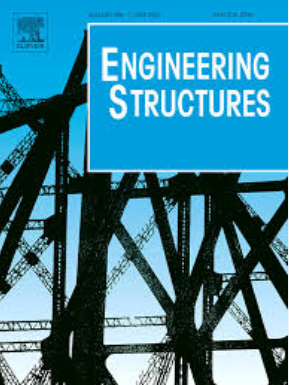从单态元素设计拓扑互锁结构的一个广义框架
IF 5.6
1区 工程技术
Q1 ENGINEERING, CIVIL
引用次数: 0
摘要
拓扑互锁(TI)结构以其优异的能量耗散、损伤容限和适应性而闻名,作为先进结构设计的创新解决方案,越来越受到人们的关注。在本研究中,开发了一个通用框架,用于设计具有弯曲接触面的TI元件,通过匹配的凹凸界面创建单态元件。单元形状由诸如多边形类型、多边形长度、曲线函数和单元厚度等参数控制。该方法可应用于平面和非平面结构的TI元件设计。通过设计24个平面和12个非平面TI元件以及两个3d打印原型来实现验证。此外,将典型TI板的冲击性能与单片结构进行了比较,以证明通用联锁机制的有效性。本文章由计算机程序翻译,如有差异,请以英文原文为准。
A generalised framework for designing topological interlocking structures from monomorphic elements
Topological interlocking (TI) structures, known for their superior energy dissipation, damage tolerance, and adaptability, are gaining increasing attention as innovative solutions to advanced structural designs. In this study, a general framework is developed for designing TI elements with curved contact surfaces, enabling the creation of monomorphic elements through a matched concavo-convex interface. The element shapes are controlled by parameters such as polygon type, polygon length, curve function, and element thickness. This approach can be applied to designing TI elements for both planar and non-planar structures. Validation is achieved through the design of 24 planar and 12 non-planar TI elements, along with two 3D-printed prototypes. Furthermore, the impact performance of typical TI plates is compared to that of a monolithic structure to demonstrate the effectiveness of the generalised interlocking mechanism.
求助全文
通过发布文献求助,成功后即可免费获取论文全文。
去求助
来源期刊

Engineering Structures
工程技术-工程:土木
CiteScore
10.20
自引率
14.50%
发文量
1385
审稿时长
67 days
期刊介绍:
Engineering Structures provides a forum for a broad blend of scientific and technical papers to reflect the evolving needs of the structural engineering and structural mechanics communities. Particularly welcome are contributions dealing with applications of structural engineering and mechanics principles in all areas of technology. The journal aspires to a broad and integrated coverage of the effects of dynamic loadings and of the modelling techniques whereby the structural response to these loadings may be computed.
The scope of Engineering Structures encompasses, but is not restricted to, the following areas: infrastructure engineering; earthquake engineering; structure-fluid-soil interaction; wind engineering; fire engineering; blast engineering; structural reliability/stability; life assessment/integrity; structural health monitoring; multi-hazard engineering; structural dynamics; optimization; expert systems; experimental modelling; performance-based design; multiscale analysis; value engineering.
Topics of interest include: tall buildings; innovative structures; environmentally responsive structures; bridges; stadiums; commercial and public buildings; transmission towers; television and telecommunication masts; foldable structures; cooling towers; plates and shells; suspension structures; protective structures; smart structures; nuclear reactors; dams; pressure vessels; pipelines; tunnels.
Engineering Structures also publishes review articles, short communications and discussions, book reviews, and a diary on international events related to any aspect of structural engineering.
 求助内容:
求助内容: 应助结果提醒方式:
应助结果提醒方式:


